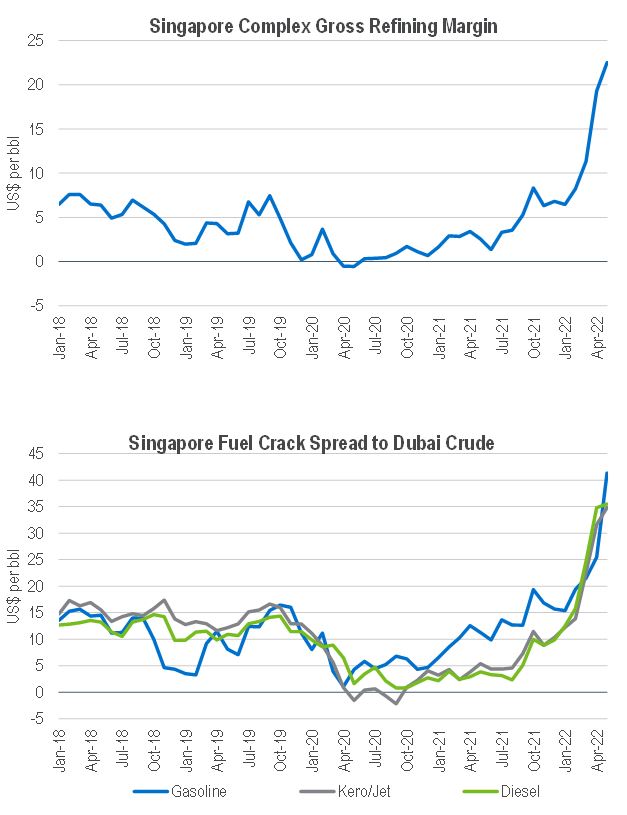Oil Refineries: The Return of a Golden Era?

You run an oil refinery. You went through depressed refining margins throughout the pandemic. You thought about closing down but you decided to persist. You now find yourself highly profitable from record high refining margins. What should you keep an eye on in the near future?
NexantECA - Oil Refineries: The Return of a Golden Era?
Keep an eye on demand trends.
Demand for gasoline and diesel globally has been strong, as most countries are already seeing consumption levels equivalent to pre-pandemic times. China has not fully relaxed its COVID-19 related restrictions, hence there is potential for more pent-up fuels demand. However, high inflation and global recession may quickly reverse demand growth. The United States Federal Reserve increased by a 0.75 percentage point interest rate hike on 15 June, its biggest interest rate hike in 30 years, to mitigate sky high inflation. Expect volatile financial markets and slower global economic recovery in the coming months. Fuel demand growth may soften as the population has less disposable income. If you are a refiner serving markets with subsidised fuels, be prepared for an impact on demand as governments consider subsidy reductions or removal to reduce further strain on its resources. Fuels demand is highly elastic to retail pricing changes in a market which is used to subsidies.
Keep the other eye on feedstock trends.
Crude oil prices are getting notoriously difficult to predict. After a period of stability before the COVID-19 pandemic, crude pricing volatility has been severe. It was only two years ago that crude oil prices hit rock bottom, with prices below US$ 30 per barrel. But has now soared to over US$ 120 reaching levels last seen in 2014 and previously in 2008 due to combination of factors, further exacerbated by the Russian-Ukraine conflict. Experienced refiners would understand market conditions can quickly change, as any geopolitical event, economic recession or health risks can have adverse effects on crude prices. Global supply remains constrained. It seems most major crude producers are unable or unwilling to increase production despite high prices. U.S. shale producers have, in general, been reluctant to increase production as shareholders remain cautious to invest or demand more cash return post-pandemic. Any form of investment in developing crude production presently would also encounter high cost and supply chain constraints. The U.S. may consider relaxing sanctions on Venezuela and Iran to bring more supply into the global market.
Persist but diversify in view of increased competition.
One of main reasons for high refining margins is insufficient refining capacity to meet refined products demand. This is mainly due to refining capacity closures at various locations during the pandemic. Refinery closures outweighed new capacity in 2021, the first time this has happened in 30 years. Global net capacity fell by 730 thousand barrels per day (kbpd) as around 1.6 milllion bpd was shut or converted into bio-refineries with 850 kbpd coming online. It is highly unlikely that closed capacities will be brought back online. Hence, supply development would be on new refineries which are already under development and construction mainly in Middle East and certain parts of Asia. New refineries under development are typically large and complex, and expected to be highly cost competitive when they commence operation in the coming years. Hence, while pure play oil refineries enjoy better fuel margins presently, it is prudent to look at how to invest in diversifying. This applies to both products and feedstock. Refineries should look at how they can produce products beyond fuels. Petrochemicals demand had been holding up well relative to fuels throughout the pandemic. But as refiners are enjoying a resurgence in margins, petrochemicals have been struggling, with olefins cracker margins at record low in Asia. Feedstock diversification not only comes from flexibility in processing different crude qualities but also alternatives such as waste and biomass.
Enjoy short term gains but do not ignore long term structural shifts.
Decarbonisation, adoption of electric vehicles and sustainability shall remain as key energy priorities and development opportunites in the long term. Refineries should not lose sight of these as they enjoy high fuel margins. This may be a window of opportunity for refineries to invest and better prepare themselves for these developments. Investing in reducing refining carbon footprint such as carbon capture and storage or electrifying operations with renewable energy seems sensible, although economic justification may not be apparent in selected countries. Sustainable feedstock, renewable fuels, hydrogen and other forms of new energy are all new areas refineries can look at. Careful consideration should be made at areas of investment as they will vary depending on market and regulatory developments.
This is perhaps a rare window of opportunity for refiners to enjoy record high profits, but refiners should not lose sight of future energy market developments. Prudent refiners should look at investments to increase competitiveness, putting themselves in the best position possible as they seek to remain relevant and sustainable in a lower margin environment. While keeping a close eye on developing demand and supply trends, refineries should consider investments in technology or modifications which result in better feedstock flexibility, not just ability to process different crude quality but also waste or biomass, and lower carbon operations.
In view of uncertainties facing global refining industry, what is the prospect and key challenges moving forward? NexantECA has extensive in-house data and deep expertise in the refining and petrochemicals industry, and has supported our clients in developing strategy and plans to address sustainability challenges in the industry. Please contact us to learn more.
FInd out more...
NexantECA Subscriptions and Reports business provide clients with comprehensive analytics, forecasts and insights for the chemicals, polymers, energy and cleantech industries. Using a combination of business and technical expertise, with deep and broad understanding of markets, technologies and economics, we provide solutions that our clients have relied upon for over 50 years.
The Author
Kevin Soh, Managing Consultant
